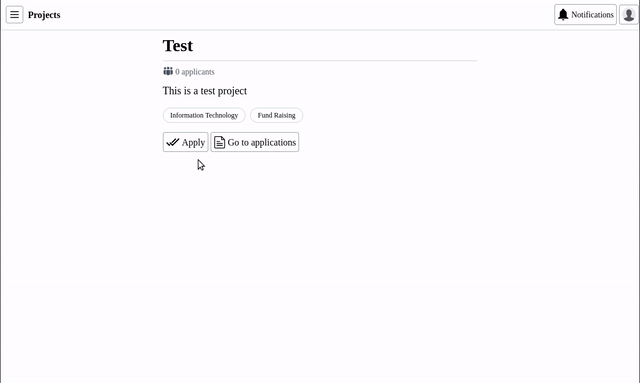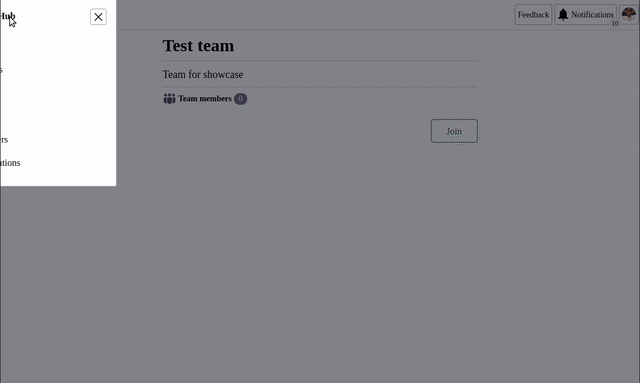Project overview #2 - EESTEC Hub
EESTEC Hub is an HRM platform designed to suit the human resource automation needs of student organizations.
Table of contents
- The problem
- The proposed solution
- The development
- The result
- Future of development
- Tech stach
- Source code and contributing
If you dont want to read the whole development story and want to go straight to results, go to the result section
The problem
EESTEC LC Novi Sad is a rather large student organization with around 200 active members. Board members have a big task of following each members activity within the organization. Activity is considered anything from attending organization events to being a part of an internal team or being a part of a project organizing team.
Tracking members activity is very important as the Board of the organization has to give priorities to more active members when it comes to getting travel reimbursements and when it comes to events with limited spots available. The board also needs to know the evaluation of each member that applies to work on some project as the coordinator spots on projects are limited also.
How the Board members used to solve this was by having a spreadsheet ( before the spreadsheet this was done on paper 😨 ) where they would write when some member attended an event or when some member would join a team. This was, as you can imagine, very clumbersome and error prone.
This activity tracking has historicaly been known to have lost data, data that was hard to understand by the Board. Many times Board members restart the evaluation and tracking process every year as the data from the year before is missing or very poor.
The proposed solution
Enter EESTEC Hub. The idea behind this app was quite simple. It was supposed to have a limited but usefull set of features like
- User authentication - All members having their user profiles
- Projects - Board members create them so that members can apply
- Events - Board members create them and members can enter
- Teams - Members should be able to join teams
- Point system - All users should be able to be evaluated based on activity
- Member management - Board members should be able to manage members
The development
For the solution of the problem I went with NextJS with Tailwindcss and MongoDB. I went with this stack sice I am very comfortable with it and I didn’t have much time to experiment. You can find a more details on the tech stack segment.
This app was going to be used mostly by the members from mobile devices so I knew that I had to go with the mobile-first approach. This was quite easy to do with Tailwindcss and I found that it definetely reduced the time of development for me a lot. The downside was that I was left with kind of long html tags. Like this div for example:
<div className="flex justify-between items-center py-2 border border-solid border-gray-300">But once you accept this, your life becomes much easier.
Problem with forms
I had a big headache with forms in NextJS. When you read the official docs, you are incentivized to make your components server rendered as much as possible. This is because pages rendered on the server perform much better and the SEO is way better compared to classical React client rendered components.
As you can imagine this application had a lot of <form> elements in it by
design:
- User log in and sign up
- Resseting password
- Creating projects
- Creating teams
- Creating events
- Joining events
- Registering members
- Editing a profile
- Maybe more
When you create forms in this way you can’t have any state, so you are left with a basic web-1.0 form with the only difference being that the form doesn’t have to call an API and can call a server action instead.
This was a form that created a new project:
// src/app/projects/new/page.js - commit a265d06
<form
action={async (formData) => {
"use server";
const projectData = {
name: formData.get("pname"),
// and some more data...
};
const proj = await createProject(projectData);
redirect("/projects");
}}
>
<input name="pname" />
<!-- Some inputs are removed for simplicity -->
<Button className="w-full md:w-64 mt-4" type="submit">
Create new project
</Button>
</form>We reach a point where there are a couple of problems with this approach:
- The user can spam the button, this can create a lot of traffic on the server
- There is no way to display any indicators of sucess or failure since there is no state
Solution to the forms problem
The solution to this was to ditch server components whenever I had to use the form element. I can just say that this was not a small endeavour 😀
This is how basically every component with forms looked like:
Firstly we have a server component that would look something like this
// src/app/projects/new/page.js
export default async function NewProjectPage() {
const session = await auth();
if (!session || !session.user || session.user.role !== "board") {
redirect("/login");
}
return <NewProjectForm />;
}Secondly we have a client component that handles the state as well as the form submission
// src/app/projects/new/NewProjectForm.js - truncated for readability
export default function NewProjectForm() {
const [formState, formAction] = useFormState(createNewProject, null);
const [submitting, setSubmitting] = useState(false);
const formRef = useRef(null);
const handleButtonClick = () => {
setSubmitting(true);
formRef.current.requestSubmit();
};
useEffect(() => {
if (formState?.success) {
// Handle success
} else if (formState?.error) {
// Handle errors
}
setSubmitting(false);
}, [formState]);
return (
<form
ref={formRef}
action={formAction}
>
<!-- Some inputs and a button... -->Problem with calculating member points
The other problem was calculating member points. I had imagined it going this way:
- Every event entry gives you some amount of points
- Every day of you being in a team or project gives you some amount of points
The event entry was easy, when the member enters an event via code, just update the database:
const updatedEvent = await Event.findByIdAndUpdate(eventId, {
$addToSet: { attendees: user.id },
});But the problem was sending the query every day at the same time to check whether
the user is a part of some project or team. Since the whole platform is
deployed on Vercel, everything is done via serverless functions. This means
that I cannot just have a setInterval function run on a server - the server
kinda doesn’t exist ( it does but you know what i mean ).
Vercel supports cron jobs but they are not free. Since I had a budget
for this project of around $0 I had to find another way.
The solution to the points problem
So the solution was actually quite simple in retrospective, but I had never been in contact with cron jobs before this so be easy on me dude!
The solution was to have an api route that goes through all of the members and calculates and updates their point count. This api would get hit every day at midnight by Github Actions cron job.
The API endpoint:
// src/app/api/members/calculate/route.js - truncated for visibility
export async function GET(req) {
if (
req.headers.get("Authorization") !== `Bearer ${process.env.CRON_SECRET}`
) {
return new Response("Unauthorized", {
status: 401,
headers: {
"Access-Control-Allow-Origin": "*",
"Access-Control-Allow-Methods": "GET, POST, PUT, DELETE, OPTIONS",
"Access-Control-Allow-Headers": "Content-Type, Authorization",
},
});
}
await dbConnect();
// ... go and calculate pointsAs you can see, I added auth to this api via CRON_SECRET variable. This is so
the api doesn’t get molested by bots or malicious users.
The secod part of this was the Github Action:
// .github/workflows/cron.yml
name: Score Calculation
on:
schedule:
- cron: '0 0 * * *' # Daily at midnight
jobs:
calculate-points:
runs-on: ubuntu-latest
steps:
- name: Trigger score calculation
run: |
curl -X GET "https://eestec-hub.vercel.app/api/members/calculate" \
-H "Authorization: Bearer ${{ secrets.CRON_SECRET }}"Pretty simple right?
The result
The result from all of that work is a feature rich application that is yet to be tested in the real scenario, we are beta testing right now. Here is the user flow:
Authentication
All users must authenticate. The user can optionaly request an account via registering.

Optionaly, there is a password reset functionality if the user forgets their password.
Projects
The board members have the ability to create new projects.

The regular members can then apply to these projects, while the board members
can later look at the applications

Events
The board members can create events that the rest of the members can see in
their notifications.

The regular members can then attend an event by inputing a secret value that
the only board members have.

Teams
board members create teams that rest of the members can join

Member management
board members can manage the rest of the members by registering new users

Future of development
The bigger part of the development is behind us. The thing that is left is writing tests and fixing buggs. I will leave this up to the team tho, as I have poured many lone hours into this project and kinda got burnet up by it.
Tech stack
- Next.js - For basically everything
- Vercel - For hosting
- MongoDB - This is where we
store
users,projects,eventsand so on… Used mongoose for strong types - Atlas - To host the database
- Vercel blob - To store the user profile images
- Tailwindcss - To take a rest from css and have an easy time with responsive design
- jsdoc - To help with types. Came in very clutch when the codebase started growing, very good for code completion
- Github Actions - For cron jobs
- authjs - For user authentication
Source code and contributing
The source for the project can be found on the orgs github . I welcome everyone and anyone to post an issue or a PR.
If you are a part of another student organization and would want to incorporate this, but don’t understand how to fork this repo, feed free to get in touch with me via email
Comments